Snakes come in different colors. Some of them are multicolored while others are identified by a single color. Purple snakes can have partial or full purple coloring.
Purple is atypical for snakes. This is why the color is even integrated into the name of certain snake species given its unusual nature.
There are multiple purple snakes around the world. Most people are only familiar with Lavender corn snakes which have purple coloring. However, there are at least a few other snakes with purple coloring.
Table of Contents
Types of Purple Snakes
The following snakes are commonly purple or they have purple versions. Many of them are seen through North America.
1. Western blind snake
Scientific name: Rena humilis.
Common name: western blind snake, western slender blind snake, western threadsnake.
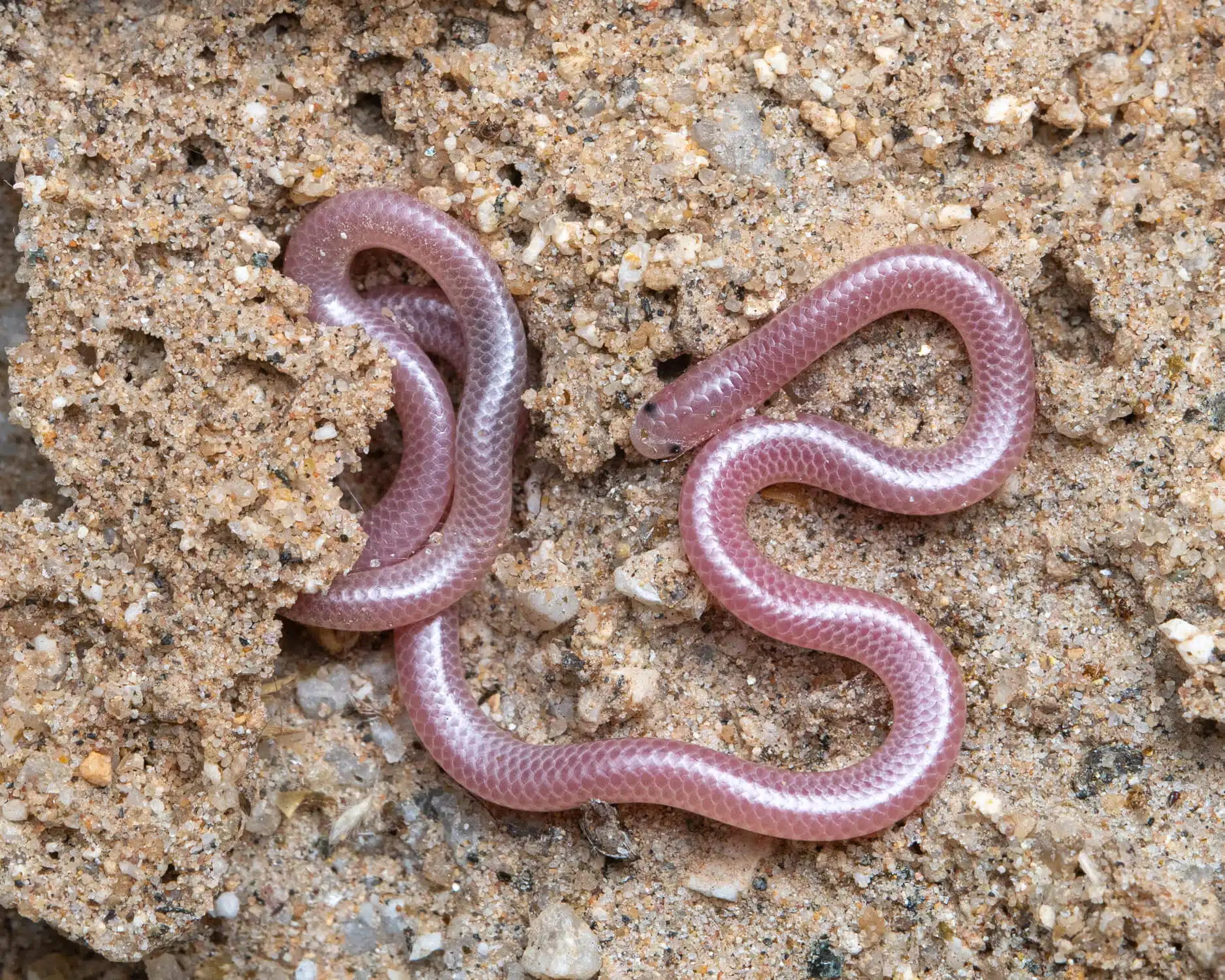
With a common presence in Southwestern, this snake is known for being blind. It lives underground and it’s believed it has lost vision as it has no need for it in the dark.
This snake is commonly purple or pink.
However, it’s rare to see a Western blind snake easily as it lives deep underground. Some snakes of the species live at depths of down to 66 feet.
Western blind snakes rarely seen in the US are rather small, similar to the size of earthworms. It grows to around 12 inches in adulthood.
2. Banded Rock Rattlesnake
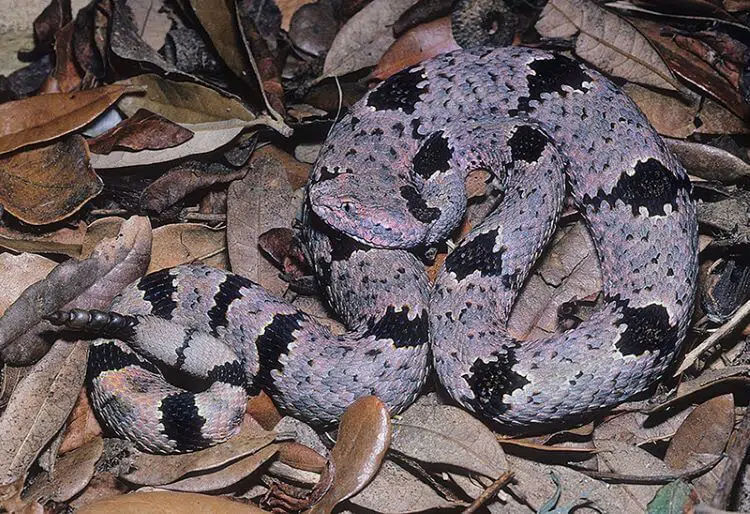
Scientific name: Crotalus lepidus klauberi.
Common name: anded rock rattlesnake, green rattlesnake, green rock rattlesnake.
The Banded Rock Rattlesnake is another common species in the Southwestern United States. This snake is known for its gray body with darker gray banding.
Darker gray banding on this snake is sometimes purple.
Seeing a Banded Rock Rattlesnake is not easy. This is a nocturnal snake that goes out of its way to hide during the day.
It lives in crevices and under rocks. The snake is also known for not traveling far either. It can spend its entire life on a certain ridge.
3. Corn Snake

Scientific name: Pantherophis guttatus.
Common name: corn snake, American corn snake.
The Corn snake is one of the most popular pet snakes around the world. Bred in high numbers, it has already started to alter its genetic heritage morphing in various colors.
4 types of Corn snakes have partial purple coloring. These are Lavender Corn snakes, Lava corn snakes, Plasma corn snakes, and Opal corn snakes.
These are all gray snakes with purple markings except Opal snakes. The Opal Corn snake has a bright color body with pink to purple markings.
Lavender morph Corn snakes have similar coloring to Opal snakes. They have a darker grey body color with dark purple markings.
4. Ball Python
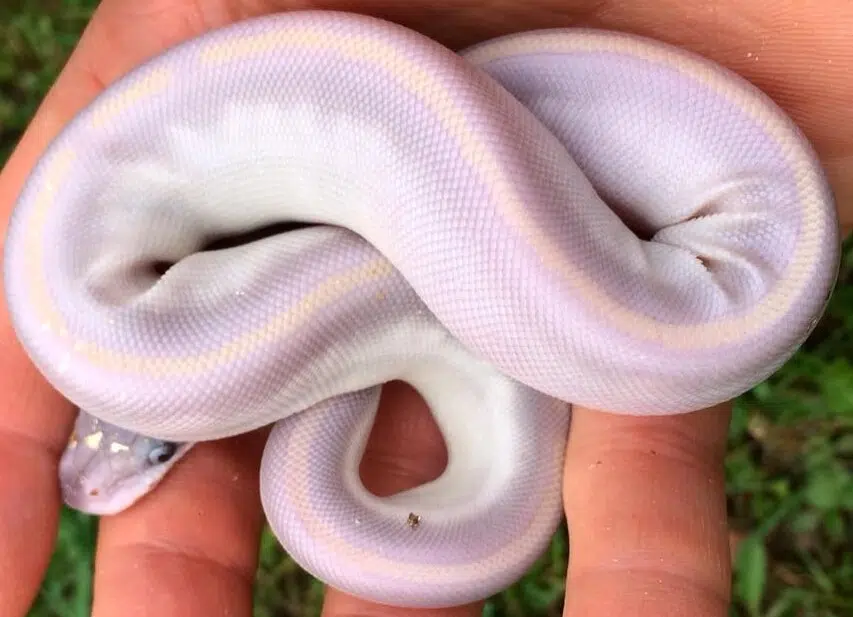
Scientific name: Python regius.
Common name: ball python, royal python.
Ball Python snakes are some of the most common pet snakes. They are known for unique morphs.
Purple passion morph is achieved by mixing Mojave and Phantom morph. The final result is a light pink and light purple snake that grows up to 5 feet.
5. Reticulated Python
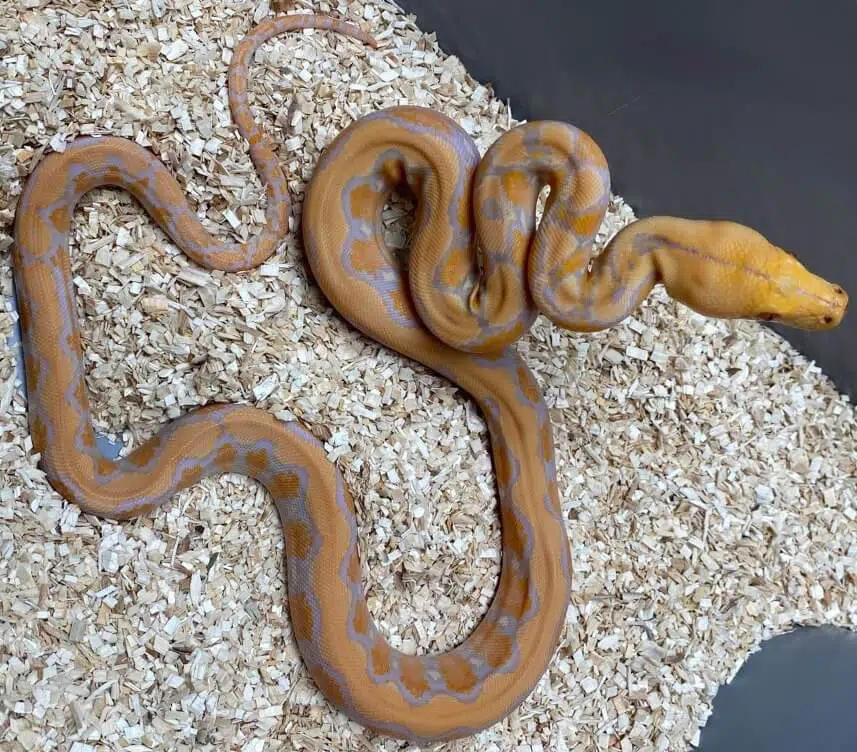
Scientific name: Malayopython reticulatus.
Common name: reticulated python.
The Reticulated Python is found in parts of Asia. As the world’s longest snake, it also has high value as a pet snake.
Its Purple albino morph is known for its yellow color with purple markings that run along its body. This snake reaches a maximum length of 5 feet only when in captivity.
It largely grows only in captivity where it prefers high humidity tanks.
6. Cape file snake
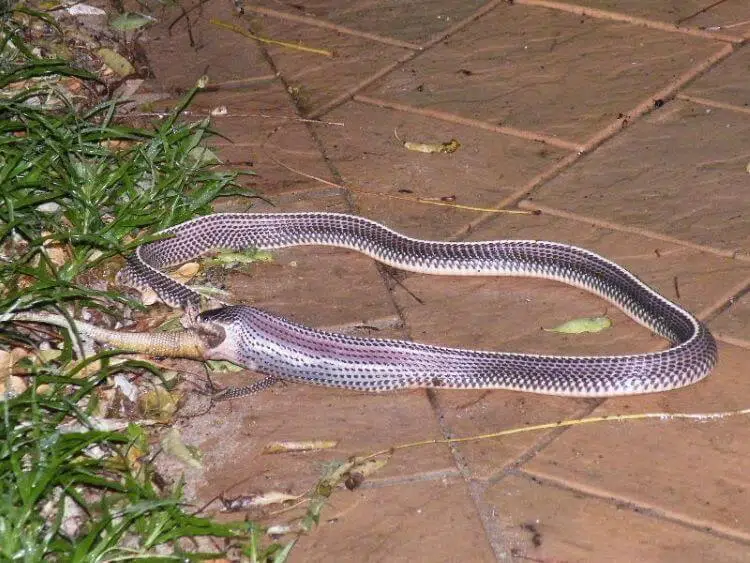
Scientific name: Limaformosa capensis.
Common name: Cape file snake.
This snake is common in Africa, while not poisonous, it often appears as poisonous due to its colored body.
Cape file snakes are mostly found in gray coloring with brown markings. In rare cases, it also appears with wide pink to purple markings on its body.
The purple coloring is prominent between the snake’s scales.
7. California Kingsnake
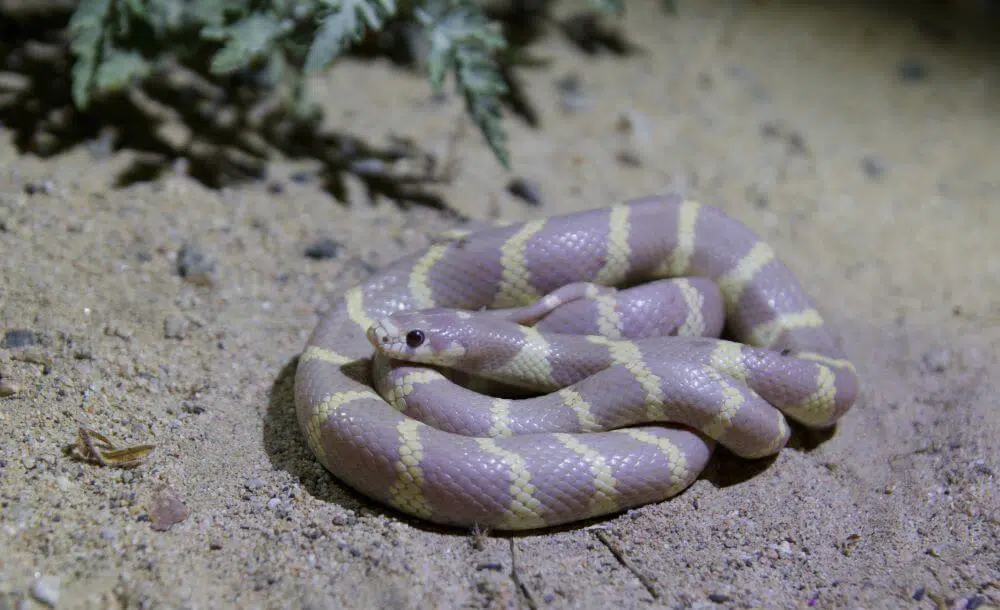
Scientific name: Lampropeltis californiae.
Common name: California Kingsnake.
The Purple Passion California Kingsnake is a California Kingsnake morph mostly seen in captivity with very rare sights out in nature.
This snake is characterized by bright body coloring. It has a yellow body with pink markings that can turn purple in adulthood.
Casper Ghost California Kingsnake morphs are also pink with hints of purple. This snake differs from the Purple Passion morph as it has no yellow coloring.
8. File Snakes
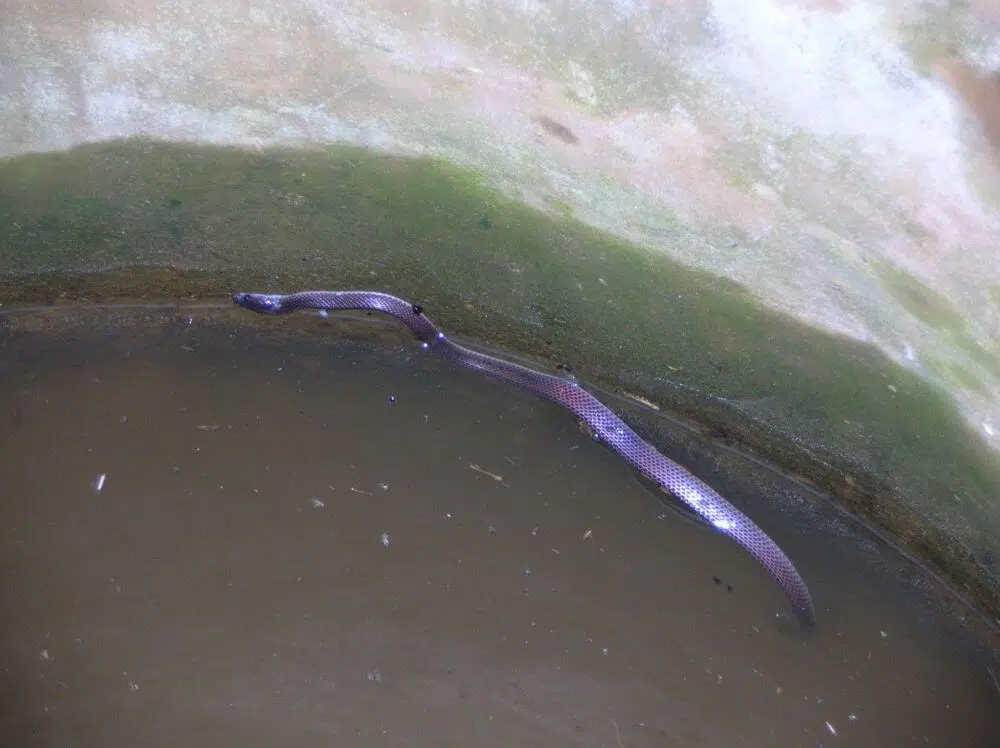
Scientific name: genus Mehelya.
Common name: File snakes.
The File snake is mostly gray-brown. It’s known for having purple skin between the scales.
Part of the Colubridae snake family, this is a large non-venomous snake. As an avid hunter, it prefers to prey on other smaller snakes.
9. Mangrove Viper
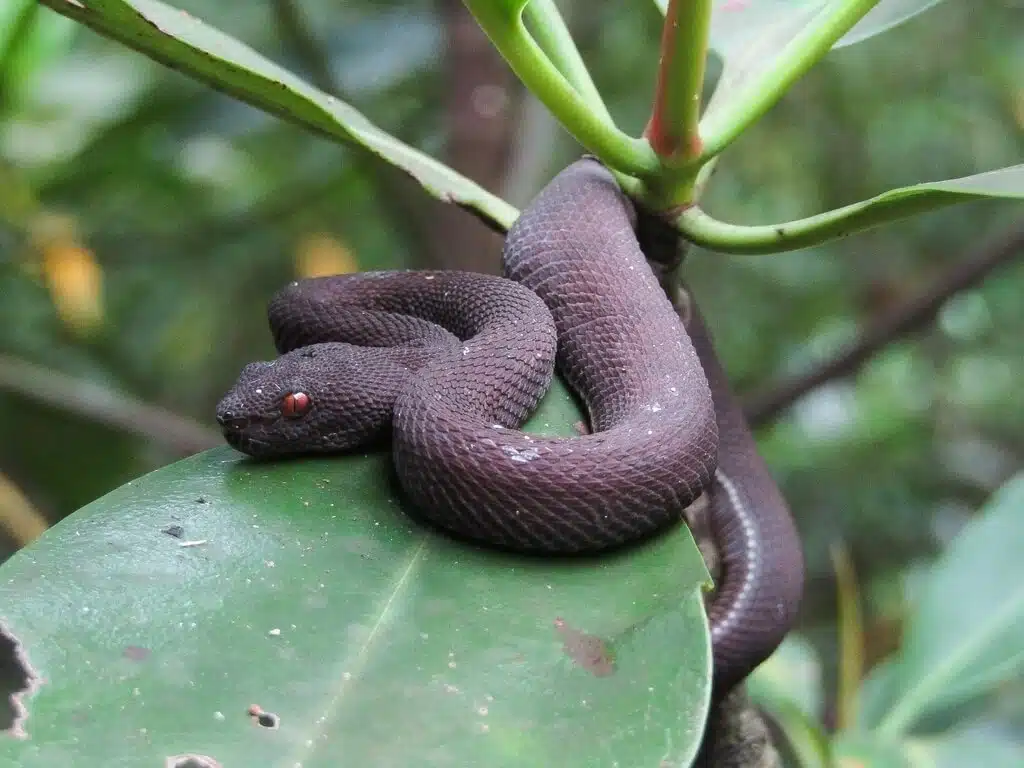
Scientific name: Trimeresurus purpureomaculatus.
Common name: mangrove pit viper, mangrove viper, shore pit viper.
A venomous species of Southeast Asia, Mangrove Vipers often come on purple.
Various dark shades of purple are often specific to this species. From dark purple to purple-gray nuances, this is a species that has a patterned dorsum as well.
The patterns themselves can have a darker purple nuance. Alternatively, they can be gray, brown, and even black.
In some cases, Mangrove Vipers are gray-brown with purple blotches and a purple head.
Colorful but still atypical nuances are also specific to its eyes.
Mangrove Vipers often have orange and red eyes. Blue eyes with vertical pupils are also seen on this highly venomous snake.
10. Common Purple-glossed Snake
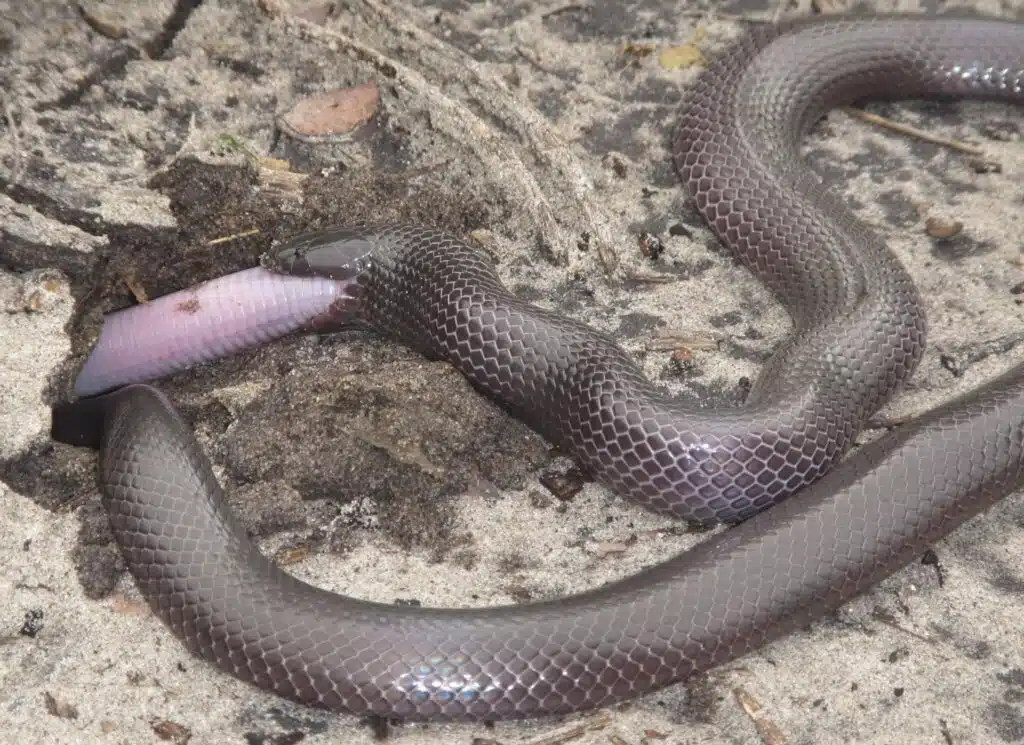
Scientific name: Amblyodipsas polylepis.
Common name: Common Purple-glossed Snake.
A species of South African, Common Purple-glossed Snake is highly elusive and still rather unknown.
Living most of their lives underground, these are the types of snakes that are rarely seen, if ever.
Some of the times they come out at the surface include heavy rainfall or accidental ground excavation.
Growing to a size between 20 and 30 inches, Common Purple-glossed snakes are among the species known for their purple color.
A dark species, this snake has a black-to-purple color.
A rare nuance in the snake world, this is among the darkest purple nuances to be discovered today.
The snake has smooth shiny dorsal scales and large scales on the head.
It features the same purple nuance both across its dorsum and across its ventral side.
Long believed to be dangerous, this is not a temperamental snake. It doesn’t produce any venom either.
11. Olive Sea Snake
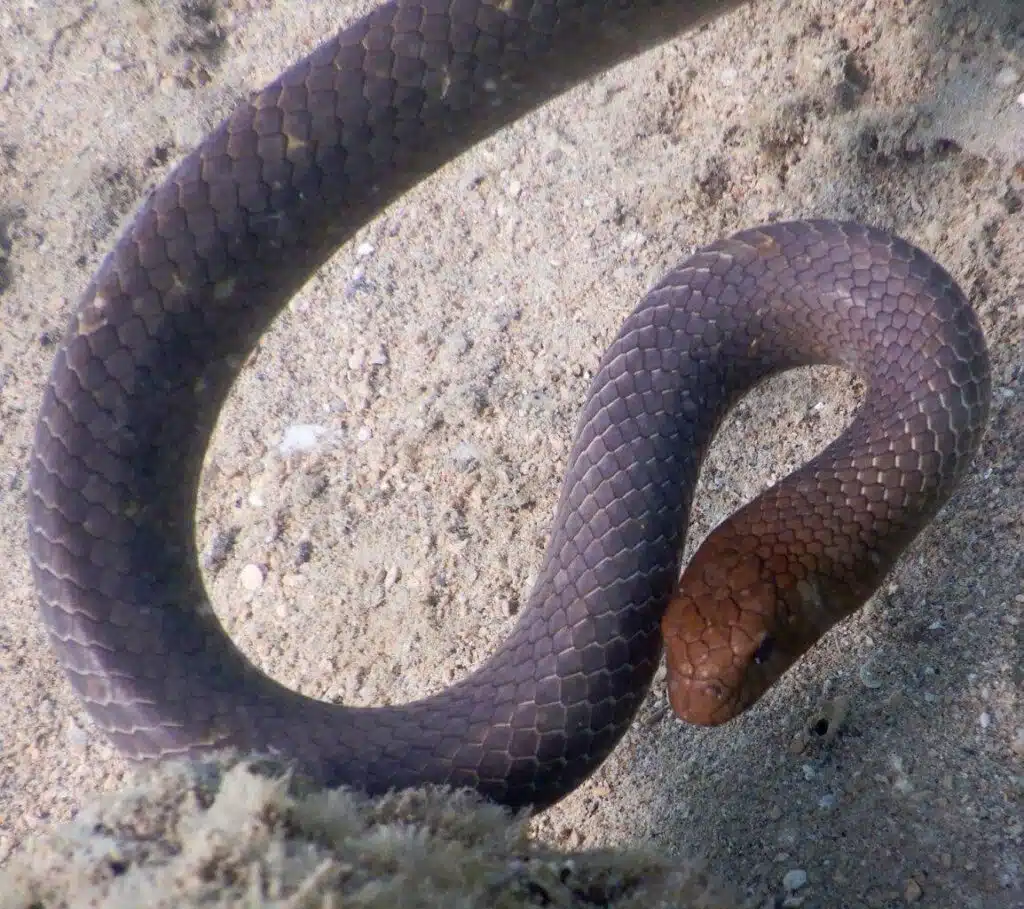
Scientific name: Aipysurus laevis.
Common name: golden sea snake, olive sea snake, olive-brown sea snake.
Olive Sea Snakes are the most venomous types of sea snakes according to research.
These highly venomous snakes live in the sea, coming up to the surface to breathe.
They are known for having a rare brown-purple nuanced covering their entire body. Some morphs come with a separate brown head color.
A bright purple nuance on a brown base underlayer is specific to this species with large scales.
The venomous snakes are found in the seas and oceans of the world, most notably around The Great Barrier Reef.
It eats fish, crustaceans, and other sea creatures by relying on its venom which incapacitates them.
Ambushing techniques are frequent for the snake that hides among reefs for its prey to arrive.
12. Brahminy Blindsnake
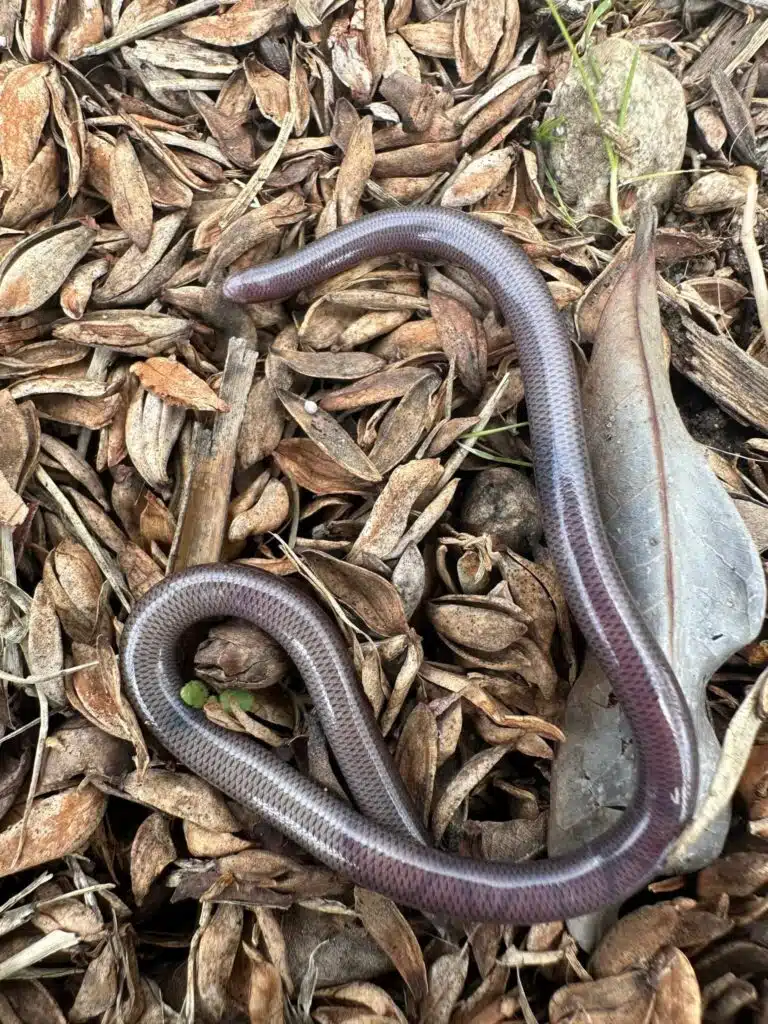
Scientific name: Indotyphlops braminus.
Common name: Brahminy Blindsnake.
Brown and brown-purple nuances are specific to one of the smallest snakes in the world, The Brahminy Blindsnake.
The purple nuances vary from brighter to darker. The areas around its head are brighter, slowly darkening towards the tip of the tail while its snout is mostly white or cream-colored.
This is a small species that may reach a maximum length of 5 inches. It has a glossy smooth appearance with purple nuances along the dorsum and ventral side.
Living in the ground, Brahminy Blindsnakes don’t need vision. They cannot even see.
Often taken as earthworms, these types of snakes play a positive role in the ecosystem, feeding on bugs and insects in the ground.
More abundant in Africa and Asia, it is believed The Brahminy Blindsnake can be found on all major continents.
13. Blackish Blind Snake
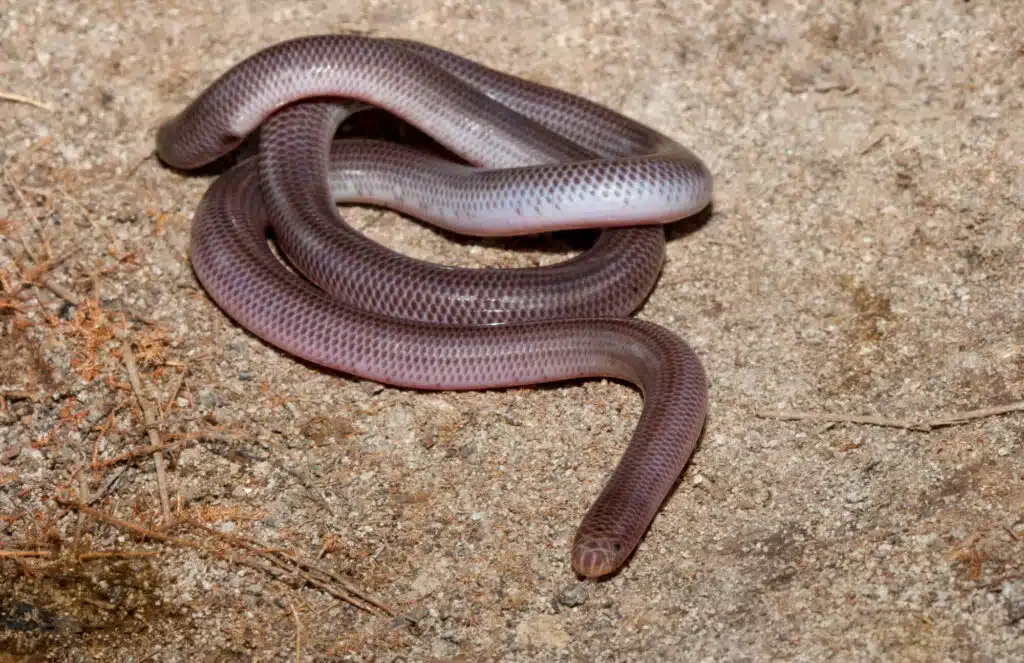
Scientific name: Anilios nigrescens.
Common name: Blackish Blind Snake.
Dark purple colors represent the main nuance of The Blackish Blind Snake.
This species also lacks vision but comes in a darker nuance and almost appears black.
A burrowing species, this snake grows to an expected size of 6.5 inches and has a glossy worm-like appearance and shape.
Its head is small, as wide as its body, and also of a dark purple-black appearance.
The snake can be found in the ground or above the ground in leaf litter in Florida.
Feeding on ants and termites, Blackish Blind Snakes can be used as an indicator of a potential invasion and considerable problems for homes.
Uncovering the snake in your garden might signal it’s time to call a termite exterminator as they often surface in areas with plenty of underground termites.
14. Eurasian Blind Snake
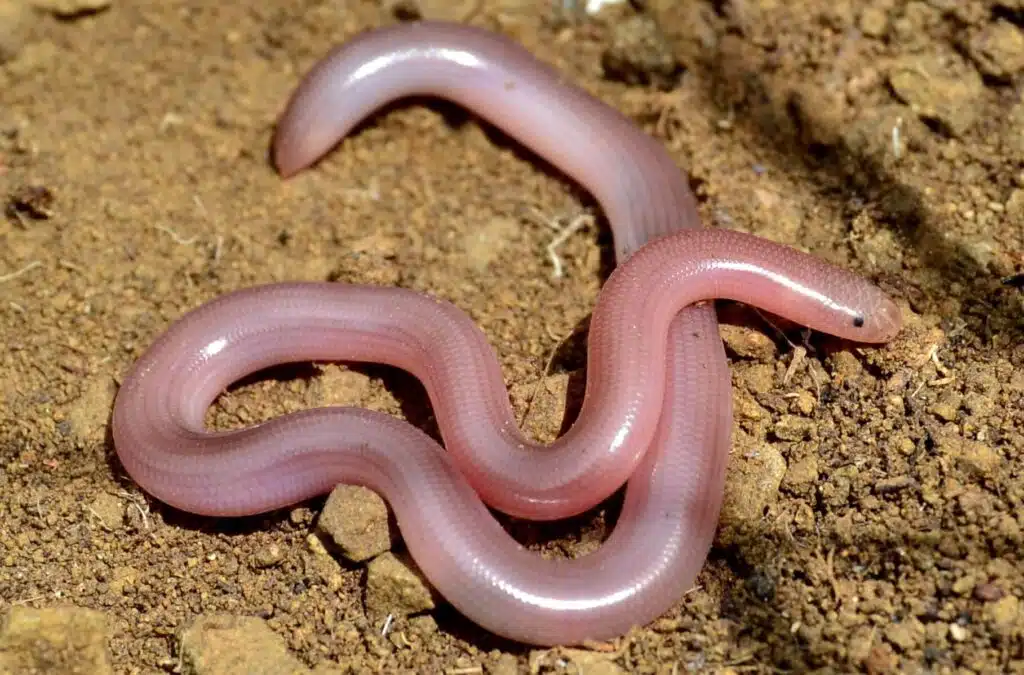
Scientific name: Xerotyphlops vermicularis.
Common name: European blind snake, European worm snake, Eurasian blind snake, Eurasian worm snake.
Purple-brown colors are specific to The Eurasian Blind Snake.
As its name implies, this is a species found both in Europe and in Asia. Its color can range slightly, depending on its region.
Eurasian Blind Snakes are also mostly pink when born. They darken to a purple or purple-brown nuance as they age.
Snakes of this genus are fossorial. They hide in the ground, only coming to the surface for food either at night or after it rains.
A thin species without vision, this snake grows to a size between 4 and 6 inches and often ends up as food for other species when it surfaces as it can’t defend itself.
15. Madurai Shieldtail

Scientific name: Platyplectrurus madurensis.
Common name: Travancore Hills thorntail snake, Palni purple-brown worm thorntail snake, Madurai shieldtail.
A mostly dark purple snake, Madurai Shieldtails are named after their colorful yellow tail tips.
Dark purple colors are specific to this snake. Its purple nuances go from almost black to dark purple.
This gradient starts at the head, ending the brightest at the tip of the tail.
Madurai Shieldtails also show yellow sections between the purple dorsal specks.
The species is also one of the smaller dark purple snakes in the world. It grows to a size between 10 and 13 inches.
16. Sharp-tailed Snake
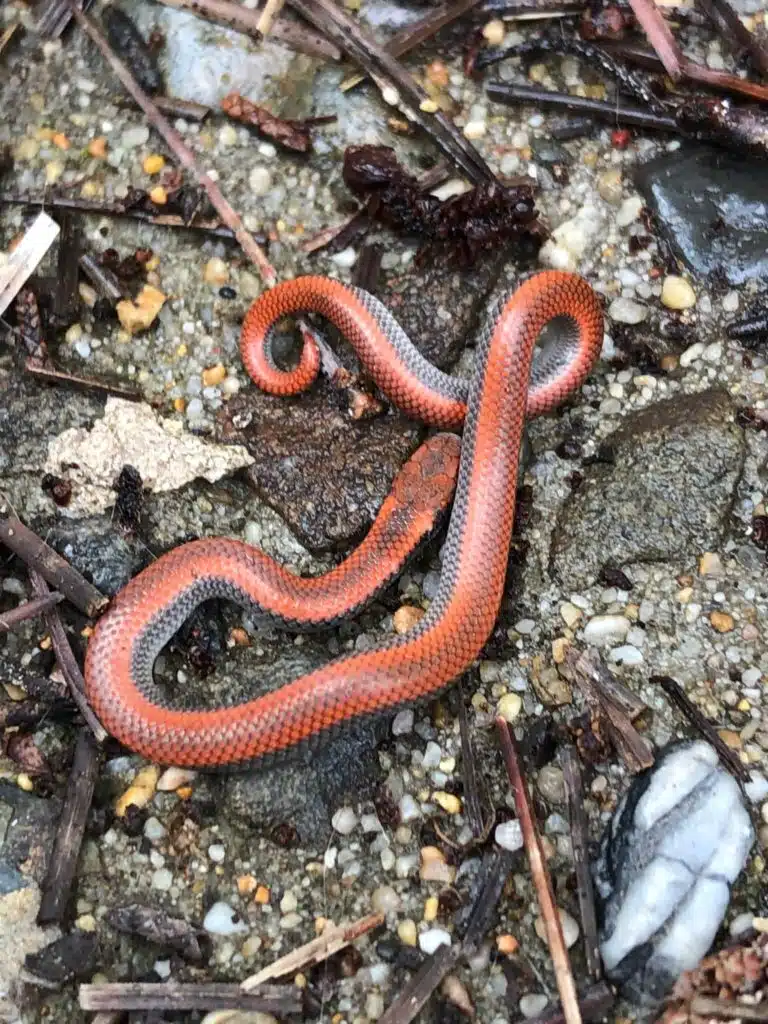
Scientific name: Contia tenuis.
Common name: sharp-tailed snake.
A short species that live in the ground, Sharp-tailed Snakes are found on the US West Coast.
Abundant in California and Oregon, Sharp-tailed Snakes are known for their brown-purple color and their white snout tips.
These snakes are routinely found in areas with slugs, which form the bulk of their diets.
Unearthed in gardens and around the house, Sharp-tailed Snakes are as small as some of the largest earthworms.
17. Bamboo Snake

Scientific name: Pseudoxenodon bambusicola.
Common name: bamboo snake, bamboo false cobra.
A species of Southeast Asia, Bamboo Snakes come in different colors and patterns, including a purple nuance.
Its ground colors are gray, tan, and brown. These colors can come with purple hues.
A ground gray-purple morph with dark brown dorsal bands is characteristic of The Bamboo Snake.
Further distinguishing traits include having black-purple patterns across the head and just behind the head, unlike the mostly brown patterns that run to the tip of its tail.
Are Purple Snakes Poisonous?
Purple snakes are generally considered harmless. They aren’t poisonous and there have not been reports of serious health impacts following their bites.
However, purple snakes haven’t been properly studied. Their venom hasn’t been the subject of extensive research.
Many purple-colored snakes live underground and they’re nocturnal creatures which means it rarely meets humans.
A considerable percentage of purple snakes are bred in captivity as pet snakes. They are believed not to be poisonous.
It’s best to exercise caution when meeting a purple snake out in nature regardless. Studies on the effect this snake’s venom has been very limited.
Exceptions apply to the category of purple snakes. For example, the Western Blind Snake is considered mildly venomous.
This snake species uses venom to immobilize prey such as frogs and lizards. On the other hand, its venom isn’t dangerous to humans or other larger animals.
Summary
Purple snakes are often found in captivity as morphs. They have a high aesthetic value as they look, unlike other snakes.
Finding purple snakes out of captivity is rare. These tend to be nocturnal snakes that live underground.
Those who encounter purple snakes out in nature typically have no real reasons to worry about. These snakes aren’t venomous.
Rare exceptions see purple snakes as mildly venomous. However, their venom is not a threat to large mammals and humans.
Many purple snakes are slender and short. They can have a bright color with pink to purple bands or marking.
All-purple snakes are rare. Even California Kingsnake morphs aren’t all purple. This is one of the most common purple snakes. Its Purple Passion morph has the most purple, but it still exhibits a pale-yellow coloring.
Further Reading: